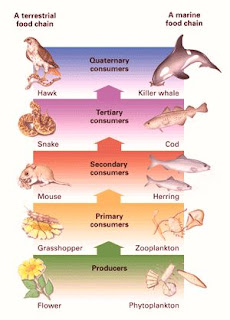Our Environment
(Study Points)
Environment:
It is the sum total of all external conditions and influences that affect the life and development of an organism, i.e., the environment includes all the physical or abiotic and biological or biotic factors.
Biodegradable Substances:
These are those substances which are broken down into simpler, harmless substances in nature with due course of time by the biological processes such as action of microorganisms like certain bacteria.
Eg. Domestic waste products, urine and faecal matter, sewage, agricultural residue, paper, wood,
cloth and cattle dung.
Non-biodegradable Substances:
Non-biodegradable Substances are those substances which cannot be broken down into simpler, harmless substances in nature. These substances may be in solid, liquid or gaseous form and may be inert and accumulate in the environment or may be concentrated in the food chain and harm the organisms.
Eg. DDT, plastics, polythene bags, insecticides, pesticides, mercury, lead, arsenic, aluminium, radioactive wastes, etc.
Ecosystem:
The inter-relation ship between biotic (living) and abiotic (non-living) components is called as ecosystem.
The study of ecosystem is called as ecology.
Biotic Component:
It means the living organisms of the environment - plants, animals, human beings and microorganisms like bacteria and fungi, which are distinguished on the basis of their nutritional relationship.
Abiotic Component:
It means the non-living part of the environment - air, water, soil and minerals.
The climatic or physical factors such as sunlight, temperature, rainfall, humidity, pressure and wind
are a part of the abiotic environment.
Types of Ecosystems:
Ecosystems are of two types :
(i) Natural Ecosystems : The natural ecosystems are terrestrial as well as aquatic. The common examples of land ecosystem are forests, grasslands, deserts, etc. The common examples of aquatic ecosystem are ponds, lakes, rivers, ocean, etc.
(ii) Human-made or Artificial Ecosystems: The artificial ecosystems are made by human beings. The common examples of artificial ecosystems are crop fields, gardens, parks, aquarium, etc.
Producers:
Those organisms which produce food by photosynthesis, i.e., organisms which can make organic compounds like sugar and starch from inorganic substances using the radiant energy of the sun in presence of chlorophyll. Producers, therefore are considered as a source of energy for those above it in a food chain.
Consumers:
Those organisms which depend upon the producers for food, either directly or indirectly by feeding on other consumers for their sustenance. Consumers therefore feed upon those below it in a food chain and are called heterotrophs.
It can be classified into primary consumer or herbivores, secondary consumer or small carnivores, omnivores and parasites.
Herbivores are the animals that consume or eat vegetation or plants, e.g., cows, hourses.
Carnivores are the animals that eat meat of other animals. e.g., tigers, wolves.
Omnivores are the animals that cat both plants and animals, e.g., humans, cockroaches.
Parasites are those organisms that live on or in the body of another organism, i.e., host from which
it obtains its nutrients, e.g., parasites of man includes fleas and lice various protozoans and tapewarms.
Decomposers:
They are those micro-organisms that obtain energy from the chemical breakdown of dead organisms or animals or plant wastes. These microorganisms are the decomposes as they breakdown the complex organic substances into simple inorganic substances that go into the soil and are used up once more by the plants. E.g. Bacteria and fungi.
Food Chain:
It is a sequence of organisms through which energy is transferred in the form of food by the process of one organism consuming the other. It shows the relationship of producer and consumers.
The length and complexity of food chains vary greatly. Each organism is generally eaten by two or more other kinds of organisms which in turn are eaten by several other organisms. The relationship can be shown as a series of branching lines called a food web. Food web is a web of cross-linked food chains.
Energy Flow in Trophic Levels:
There is a flow of energy in the form of food within an ecosystem. The flow of energy is unidirectional. The energy that is captured by the autotrophs does not revert back to the solar input and the energy which passes to the herbivores does not come back to autotrophs.

Biological magnification:
Biological magnification is a phenomenon by which toxic substances accumulate from one trophic level to another. As human beings occupy the top level in any food chain, the maximum concentration of these toxic chemicals gets accumulated in our body which becomes toxic to us.
Environment Degradation:
The use of chemicals like CFCs has endangered the ozone layer.

Depletion of Ozone Layer:
There are several reasons for depletion of the ozone layer.
- The foremost is the use of chlorofluorocarbons (CFCs).
- The other factor responsible for ozone destruction is the pollutant nitrogen monoxide (NO).
When the harmful chemicals like chlorofluorocarbons (CFC) are released into the air it accumulates in the upper atmosphere and reacts with ozone resulting in the reduction of the ozone layer by forming a hole.
Thus, the ozone layer in the atmosphere becomes thinner and gets depleted allowing more
ultraviolet rays to pass through the earth.
The Antarctic hole in the ozone layer is caused due to chlorine molecules present in chlorofluorocarbons (CFCs), that are used by human beings.
